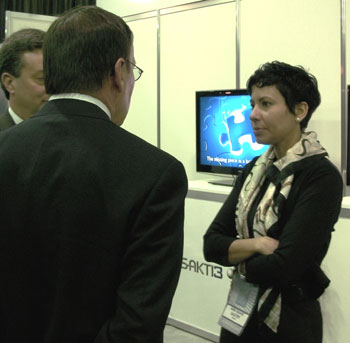Racks of engines being offloaded for testing at Lotus Engineering facility on North Main. [photo]
Stories indexed with the term ‘auto industry’
Addition to Honda Test Facility Moves to Council
An addition that more than doubles the size of the Honda testing facility on Ann Arbor’s south side won a unanimous recommendation of approval at the Ann Arbor planning commission’s Aug. 20, 2013 meeting.
The existing 19,357-square-foot building, built in 1975 and used for vehicle testing, is located at 3947 Research Park Drive on a 2.72-acre site. The proposal calls for building a two-story, 24,116-square-foot addition. Part of that square footage includes a basement level.
During a public hearing on the project, a representative of American Honda Motor Co. reported … [Full Story]
Column: On the Road
Growing up, luxury vehicles for me essentially included anything brought over from the European continent – from the classics like Mercedes-Benz and BMW to Audi, Saab and even the short-lived Peugeot 505 sedan (although looking back on it the Peugeot might have been a bit of a reach). A generation before, it was Cadillac and Lincoln marques that were held up as aspirational vehicles, with stories of people working their entire lives to finally afford a Cadillac in the driveway.
So when a colleague brought in the new Hyundai Genesis sedan to our Ann Arbor shop and described it as an early Lexus LS, I just had to see if this newest introduction to the luxury sedan segment was really as advertised. [Full Story]
Column: On the Road
Toyota is something of an instant Greek tragedy as of late. Having displaced General Motors as the world’s biggest automaker, the gods of conveyance quickly punished the Japanese automaker for hubris and success, leaving the company wandering dazed and confused in the loneliest place on earth … at number one.
But the story is more than technical problems resulting in Toyota’s largest U.S. recall ever.
It also is about Toyota’s culture and how their approach to communications during this crisis exacerbated an already difficult situation. [Full Story]
Column: On the Road
The media days preceding the 2010 North American International Auto Show in downtown Detroit kicked off to a pace that indicated far more optimism than the subdued, wake of an auto show that ran in 2009. At last year’s show, little did we know what was in store for us in the coming months – GM and Chrysler filing for bankruptcy, the lowest vehicle sales in 25 years – and it isn’t likely 2010 will be any less entertaining.
Optimism, though, seems to permeate through the show this year. Ford Motor Co., the only domestic automaker not to take bailout loans from the government, swept the North American car and truck of the year for the 2010 Ford Fusion Hybrid and 2010 Ford Transit Connect. Only two other automakers have taken the double header in the 17-year history of the award.
And GM’s chairman and CEO Ed Whitacre told reporters at the show that the federal government “had made a great investment” in effectively purchasing GM, and that he expected some $6.7 billion in loans to be paid back this year.
There still are sobering issues to deal with, though, and product will trump any good intentions as the year winds on. [Full Story]
No Secret: Sakti3 Wants Its Batteries in Cars
University of Michigan engineering professor Ann Marie Sastry – CEO and co-founder of a hot, new automotive battery development company – sits shivering in her overcoat in the cold Cobo basement at the Detroit auto show.

Ann Marie Sastry, CEO and co-founder of Sakti3, at her company's booth at the Detroit auto show. (Photo by the writer.)
But Sastry and her company, Ann Arbor-based Sakti3, is far from “out in the cold.” They are in the auto business for the long haul and do not plan on being relegated to a basement booth forever. Eventually, if all goes well, her company’s battery technology will be powering the cars upstairs on the main show floor’s Electric Avenue.
What is it about the “Eureka moment” in her UM lab that prompted her to help found a company two years ago? What is it that turned the heads and opened the wallets of the Michigan Economic Development Corp. and cleantech venture capitalist Vinod Khosla, who chipped in $2 million out the gate? What exactly is her company’s battery technology? [Full Story]
Auto Show: A Day with David Cole
Editor’s note: David Cole, who heads the Center for Automotive Research in Ann Arbor, agreed to let veteran journalist Howard Lovy shadow him during the lead-up to this year’s Detroit auto show.

Gov. Jennifer Granholm and David Cole, chairman of Ann Arbor's Center for Automotive Research, talk batteries and electric cars during a press preview day for the Detroit auto show. (Photos by the writer.)
It is the first day of the press preview for the 2010 North American International Auto Show and Ann Arbor’s David Cole is strolling down “Electric Avenue.”
The “Avenue” is an actual strip of Cobo Center real estate where electric-vehicle makers show off their wares. But it is also a branch of a metaphorical road, paved with “green technology,” that is supposed to lead to Michigan’s future.
Cole is skeptical. Not that he doesn’t think that the auto industry is getting cleaner and greener – he and his Ann Arbor-based Center for Automotive Research (CAR) have been instrumental in steering Detroit down this path. But he is skeptical that it is happening as quickly as many in politics and the media have hyped it. And the hyperbole has been flying fast and furious so far at this year’s Detroit auto show. [Full Story]
Column: On the Road
Toyota’s Prius arguably is one of the most notable, and most recognized hybrids in the marketplace today. It’s seen as a symbol of an emerging trend here in the U.S. that embraces environmental responsibility and stewardship. In its draft, the Toyota brand has built a green, eco-friendly image that has often mitigated criticism of the company’s other pickups and SUVs with considerably poorer gas mileage.
A decade from now, though, I predict the Prius will be less known for its short-term contribution to the Toyota brand or CO2 reduction, and better known for galvanizing hybrid technology in the U.S. marketplace, catalyzing the introduction of dozens of other hybrid vehicles by nearly every car company selling here.
With roughly 21 hybrid models in showrooms right now, and other 20-plus models planned for production in the next four years, its legacy will have far more impact than any one vehicle with a 50-mpg rating. [Full Story]
Column: On the Road
When I talk to out-of-state relatives, they begin the conversation with the same pity-laden inquiry: “So how’s it going out there?” By “out there” they mean the state with the worst unemployment figures, rampant foreclosures, corrupt former mayors, headline-grabbing corporate meltdowns and enough clinical depression to put a squeeze on the country’s Zoloft supply.
Michigan’s slide into unwanted notoriety has been led by the collapse of the domestic automobile industry – once an engine for the economy, and now a drag both here at home and across the nation.
But unlike last winter (and spring, and summer), the news is looking a little brighter lately. Mind you, I’m not declaring “Mission Accomplished,” but the collective headlines that came out just this week could mean the auto industry, and by association the state of Michigan, could be on the mend. [Full Story]
Column: On the Road
One thing is certain in the automobile business. When you start peeling back the onion on the performance claims and quality ratings made by and for all of the automobile manufacturers, you better have a bottle of ibuprofen at the ready. General Motors’ recent announcement that the Chevrolet Volt will get 230 miles per gallon (mpg) certainly is no exception.
First, some disclosure for your reference. I have been a big fan of GM’s efforts to create its hybrid electric vehicle and felt for some time that the car could be a positive step forward for transportation in general. I’ve been a strong supporter of GM’s many efforts in alternative transportation, from hydrogen to ethanol, as well. There are plenty of detractors around these programs – and some of the criticism is warranted. But for a company so maligned by the public as being out of date, I’ve always felt GM got a bad rap seeing how they are doing at least as much as any other car company to find solutions that take petroleum out of the transportation equation.
With that said, I found myself scratching my head trying to absorb this latest news out from GM. In principle at least, it seemed as if the Environmental Protection Agency (EPA) had just given the Volt a 230 mpg fuel economy rating, more than 10 times the average fuel economy of other cars on the road. Fantastic or fantastical? [Full Story]
Made in America

This photo of Ernie Perich and his Cadillac CTS is posted on his website, IHaveChosen.com. (Image links to closeup of the T-shirt design.)
In 1976, when Ernie Perich was a feckless youth, he and two buddies from college decided to travel to art fairs around Michigan selling “I Love America” T-shirts, tapping into the nation’s bicentennial celebration. More than 30 years later, Perich – now with the trappings of adulthood, including his own Ann Arbor ad agency and a bank directorship – is back in the T-shirt game.
Perich says that over the years he’s owned “every one of the fancy Ann Arbor German cars,” but about a year and a half ago he got a Cadillac CTS and loves it. He’s tired of hearing people dis the U.S. auto industry – plus, General Motors is one of his firm’s clients. He wanted a way to celebrate American cars and generate a little buzz, so he spent about $2,000 on T-shirts intended to do just that.
The T-shirts say ”I ♥ My (American Car)” with the last two words rendered in Japanese characters. The idea, Perich says, is to get people to wonder what the heck those Japanese words mean. A website address – IHaveChosen.com – is printed on the sleeve. On that site, you can upload photos of yourself with your car, or buy the T-shirt for $17.76 – get it? [Full Story]
Column: On the Road
I held back submitting this monthly column until the end of March to see what latest theatrics would wash over the auto industry. I wasn’t disappointed. The Obama administration looked over the homework submitted by GM and Chrysler – homework designed to demonstrate how they were going to get out of their collective messes – and sent them back to detention to do it over again.
On top of it all, long-time CEO at GM Rick Wagoner was summarily dismissed, as if one lone auto executive had been responsible for creating an unworkable fiscal structure and a corporate culture developed over decades of booms and busts in the auto business. And just for good measure, the government is insisting that Chrysler and Fiat hook up – something they were bound to do anyway – making this requirement the equivalent of forcing children to eat dessert. [Full Story]
Column: On the Road
In the continuing saga that is the U.S. automobile industry, we got introduced to a new character in the Chrysler soap opera. Just 15 months after Chrysler’s bitter divorce from Teutonic spouse Daimler AG, it has taken on a new partner: the tall, dark and very Italian automaker Fiat SpA.
Fresh with $4 billion in federal loans and in line to receive another $3 billion, Chrysler has the critics wagging their fingers at this new union like a group of English church ladies passing judgment on the town widow dating just after her spouse expired and her life insurance kicked in. (For a picture of what an English church lady looks like, Google U.S. Sen. Robert Menendez, D-N.J.) [Full Story]
Column: On The Road
If you’re one of the many Prius owners in Ann Arbor and enjoy lording your environmental sensitivity over other drivers on the road, look in the rear-view mirror. The Big Three are unveiling new concepts and new plans to put some of the most environmentally sensitive vehicles out to market, meaning Prius owners may have to trade in for a Chevy, Ford or a Chrysler if they want to continue to hold the automotive moral high ground.
New model announcements made at this year’s Detroit Auto Show (also known as the North American International Auto Show in deference no doubt to the NAFTA agreement so loved by the UAW) were prolific, despite a pall created in the wake of December’s brutal and sometimes embarrassing executive testimony in Washington D.C. Most of the green news generated came out of General Motors, Ford and Chrysler, who all tried their best to put on a positive face as U.S. auto sales continue their free-fall. [Full Story]







